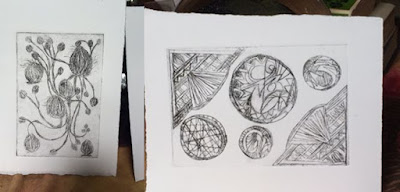I recently finished teaching a five week course in acrylic resist etching. I and my six students explored how to make hard ground, soft ground, and dry point intaglio prints using non-toxic materials, such as floor polish for a hard ground, relief ink for soft ground, soy sauce for degreasing, soda ash for a stripping solution. Some of the students were experienced printmakers, some were first time etchers, and some were first time for both. Uniformly, they each produced some spectacular prints. They were honestly better than my first efforts using these new materials, partly as a result of my long trial-and-error research into this, but mainly because of their own willingness and talent.
Here are a few images from the class. First, a hard ground with chine colle:
A couple of hard ground images mixed with drypoint:
A softground etching:
A hard ground:
Finally, a hand-coloured hard ground etching:
Here are a few images from the class. First, a hard ground with chine colle:
A couple of hard ground images mixed with drypoint:
A softground etching:
A hard ground:
Finally, a hand-coloured hard ground etching:




